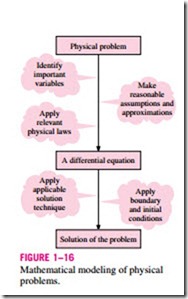MATHEMATICAL MODELING OF ENGINEERING PROBLEMS
An engineering device or process can be studied either experimentally (testing and taking measurements) or analytically (by analysis or calculations). The experimental approach has the advantage that we deal with the actual physical system, and the desired quantity is determined by measurement, within the limits of experimental error. However, this approach is expensive, time- consuming, and often impractical. Besides, the system we are analyzing may not even exist. For example, the entire heating and plumbing systems of a building must usually be sized before the building is actually built on the basis of the specifications given. The analytical approach (including the numer- ical approach) has the advantage that it is fast and inexpensive, but the results obtained are subject to the accuracy of the assumptions, approximations, and idealizations made in the analysis. In engineering studies, often a good com- promise is reached by reducing the choices to just a few by analysis, and then verifying the findings experimentally.
Modeling in Engineering
The descriptions of most scientific problems involve equations that relate the changes in some key variables to each other. Usually the smaller the increment chosen in the changing variables, the more general and accurate the de- scription. In the limiting case of infinitesimal or differential changes in variables, we obtain differential equations that provide precise mathematical formulations for the physical principles and laws by representing the rates of change as derivatives. Therefore, differential equations are used to investigate a wide variety of problems in sciences and engineering (Fig. l–16). However, many problems encountered in practice can be solved without resorting to differential equations and the complications associated with them.
The study of physical phenomena involves two important steps. In the first step, all the variables that affect the phenomena are identified, reasonable assumptions and approximations are made, and the interdependence of these variables is studied. The relevant physical laws and principles are invoked, and the problem is formulated mathematically. The equation itself is very instructive as it shows the degree of dependence of some variables on others, and the relative importance of various terms. In the second step, the problem is solved using an appropriate approach, and the results are interpreted.
Many processes that seem to occur in nature randomly and without any order are, in fact, being governed by some visible or not-so-visible physical laws. Whether we notice them or not, these laws are there, governing consistently and predictably what seem to be ordinary events. Most of these laws are well defined and well understood by scientists. This makes it possible to predict the course of an event before it actually occurs, or to study various aspects of an event mathematically without actually running expensive and time- consuming experiments. This is where the power of analysis lies. Very accurate results to meaningful practical problems can be obtained with relatively little effort by using a suitable and realistic mathematical model. The preparation of such models requires an adequate knowledge of the natural phenomena involved and the relevant laws, as well as a sound judgment. An unrealistic model will obviously give inaccurate and thus unacceptable results.
An analyst working on an engineering problem often finds himself or her- self in a position to make a choice between a very accurate but complex model, and a simple but not-so-accurate model. The right choice depends on the situation at hand. The right choice is usually the simplest model that yields
adequate results. Also, it is important to consider the actual operating conditions when selecting equipment.
Preparing very accurate but complex models is usually not so difficult. But such models are not much use to an analyst if they are very difficult and time- consuming to solve. At the minimum, the model should reflect the essential features of the physical problem it represents. There are many significant real- world problems that can be analyzed with a simple model. But it should al- ways be kept in mind that the results obtained from an analysis are at best as accurate as the assumptions made in simplifying the problem. Therefore, the solution obtained should not be applied to situations for which the original assumptions do not hold.
A solution that is not quite consistent with the observed nature of the problem indicates that the mathematical model used is too crude. In that case, a more realistic model should be prepared by eliminating one or more of the questionable assumptions. This will result in a more complex problem that, of course, is more difficult to solve. Thus any solution to a problem should be interpreted within the context of its formulation.
